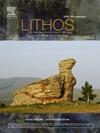U-Pb ID-TIMS baddeleyite age and geochemistry of the newly identified ca. 1.94 Ga magmatic event in the Central-Western Bastar craton
IF 2.9
2区 地球科学
Q2 GEOCHEMISTRY & GEOPHYSICS
引用次数: 0
Abstract
A NNW-trending mafic dyke from the central-western Bastar craton yields a U![]() Pb ID-TIMS baddeleyite age of 1944 ± 6 Ma. By correlating additional dykes with similar trend and geochemical characteristics, we identify a previously unrecognized dyke swarm, named herein the Pakhanjore swarm. Geochemical evidence suggests that the studied rocks are derived from partial melting of a spinel-rich, shallow lithospheric mantle source, involving 5–15 % partial melting as indicated by the non-modal batch melting model. AFC (Assimilation and fractional crystallization) modelling further reveals that fractional crystallization with moderate crustal assimilation (r = 0.3) contributes to the overall magmatic evolution. The similarity in trend of the ca. 1.94 Ga Pakhanjore swarm with the 1.89–1.88 Ga Bastanar swarm, and the ca. 1.85 Ga Sonakhan swarm of the Bastar craton suggests their emplacement occurred within a shared tectonic regime and/or paleostress field. Although notable geochemical similarities exist between the ca. 1.94 Ga Pakhanjore swarm and the 1.89–1.88 Ga and ca. 1.85 Ga mafic dykes, a direct genetic linkage remains inconclusive. However, based on available geological, geochronological, and geochemical data, the 1.89–1.88 Ga and ca. 1.85 Ga swarms appear to be part of a shared LIP event, whereas the ca. 1.94 Ga event likely represents an independent magmatic episode. The spatial alignment of all three dyke swarms with the NNW-trending Pranhita-Godavari Basin suggests a potential tectonic connection.
Pb ID-TIMS baddeleyite age of 1944 ± 6 Ma. By correlating additional dykes with similar trend and geochemical characteristics, we identify a previously unrecognized dyke swarm, named herein the Pakhanjore swarm. Geochemical evidence suggests that the studied rocks are derived from partial melting of a spinel-rich, shallow lithospheric mantle source, involving 5–15 % partial melting as indicated by the non-modal batch melting model. AFC (Assimilation and fractional crystallization) modelling further reveals that fractional crystallization with moderate crustal assimilation (r = 0.3) contributes to the overall magmatic evolution. The similarity in trend of the ca. 1.94 Ga Pakhanjore swarm with the 1.89–1.88 Ga Bastanar swarm, and the ca. 1.85 Ga Sonakhan swarm of the Bastar craton suggests their emplacement occurred within a shared tectonic regime and/or paleostress field. Although notable geochemical similarities exist between the ca. 1.94 Ga Pakhanjore swarm and the 1.89–1.88 Ga and ca. 1.85 Ga mafic dykes, a direct genetic linkage remains inconclusive. However, based on available geological, geochronological, and geochemical data, the 1.89–1.88 Ga and ca. 1.85 Ga swarms appear to be part of a shared LIP event, whereas the ca. 1.94 Ga event likely represents an independent magmatic episode. The spatial alignment of all three dyke swarms with the NNW-trending Pranhita-Godavari Basin suggests a potential tectonic connection.
中西部巴斯达克拉通约1.94 Ga岩浆事件的U-Pb ID-TIMS年龄及地球化学特征
来自中西部巴斯达克拉通的nnw向基性岩脉的UPb ID-TIMS岩石年龄为1944±6 Ma。通过对比具有相似走向和地球化学特征的其他岩脉,我们确定了一个以前未被识别的岩脉群,本文将其命名为Pakhanjore岩脉群。地球化学证据表明,所研究的岩石来自于一个富尖晶石的浅层岩石圈地幔源的部分熔融,非模态批熔融模型表明,部分熔融率为5 - 15%。AFC(同化与分块结晶)模型进一步揭示了分块结晶与中度地壳同化(r = 0.3)对整个岩浆演化的影响。约1.94 Ga Pakhanjore群与1.89 ~ 1.88 Ga Bastanar群和约1.85 Ga Bastar克拉通的Sonakhan群在走向上的相似性表明,它们的侵位发生在同一个构造体系或古应力场内。尽管约1.94 Ga Pakhanjore岩群与约1.89-1.88 Ga和约1.85 Ga基性岩脉之间存在显著的地球化学相似性,但直接的遗传联系仍不确定。然而,根据现有的地质、年代学和地球化学数据,1.89-1.88 Ga和约1.85 Ga的群似乎是一个共同的LIP事件的一部分,而约1.94 Ga的事件可能代表一个独立的岩浆事件。三个岩脉群与nnw走向的Pranhita-Godavari盆地的空间排列表明可能存在构造联系。
本文章由计算机程序翻译,如有差异,请以英文原文为准。
求助全文
约1分钟内获得全文
求助全文
来源期刊

Lithos
地学-地球化学与地球物理
CiteScore
6.80
自引率
11.40%
发文量
286
审稿时长
3.5 months
期刊介绍:
Lithos publishes original research papers on the petrology, geochemistry and petrogenesis of igneous and metamorphic rocks. Papers on mineralogy/mineral physics related to petrology and petrogenetic problems are also welcomed.
 求助内容:
求助内容: 应助结果提醒方式:
应助结果提醒方式:


